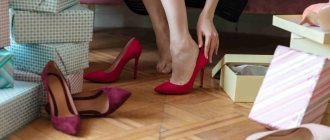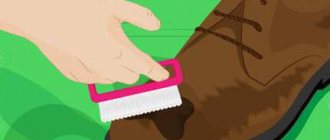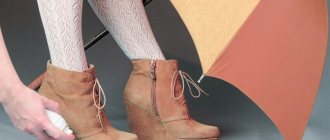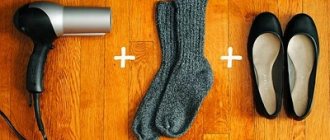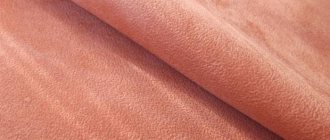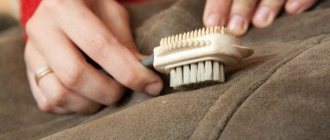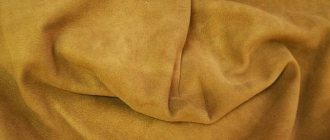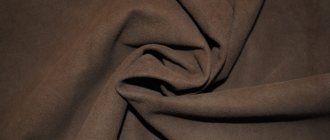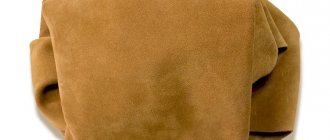Caring for faux suede shoes
Suede shoes can be made from natural or artificial material. Although they look similar, the compositions of these fabrics are very different. Therefore, they need to be cared for differently. When choosing cleaning products, you must take into account what material the shoes are made of. After all, proper care of faux suede shoes is the key to their long service life.
Conclusions and recommendations
Buying shoes made from eco-suede is an excellent option for people who value their attractive appearance, good quality at a reasonable price.
When purchasing and using shoes made of artificial suede, follow these recommendations:
- Buy products from well-known brands and in trusted stores.
- Request a warranty card for the purchased product.
- Before you make your first purchase, learn how to care for these items.
- Faux suede is not the best option for winter boots or boots. It doesn't keep your feet warm enough in winter.
- It requires careful care, thanks to which you can maintain its attractiveness for a long time.
- Do not wear these shoes in inclement wet weather - they will quickly get wet.
Basic rules of care
To ensure that faux suede shoes always look presentable and do not lose their original appearance, you need to follow a few simple care recommendations.
How to clean dirt
Artificial suede is not designed for rain and puddles, however, neither is natural suede. If your shoes do get wet, you should first dry them at room temperature. Dirt can be quickly removed with a soap solution. It is advisable not to leave dirty suede shoes like this for a long time, otherwise white stains may appear that will be difficult to get rid of.
How to return color
If the shade of your suede shoes has become lighter, it may be due to the lint. It must be lifted using a special brush. The Nettoyant cleaner sponge effectively cleans artificial and natural suede without damaging the surface texture. You can hold the boots over the steam, then the pile will also rise. In addition, after a “steam bath” all stains are removed much easier.
How to remove stubborn stains
In any unpredictable situations, suede shoes can be put in order using ammonia. It is diluted with cold boiled water in a ratio of one part alcohol and five parts water, then treat dirty areas with the resulting solution. For processing, you can use a brush with soft bristles, which you need to wipe in the direction both along and against the pile. It is advisable to complete the procedure with a weak solution of vinegar.
Faux suede is polished with a rag.
The suede began to shine
In a situation where the suede has become shiny due to long wear, you need to resort to the following folk recipe. Heat a glass of milk and dissolve one teaspoon of soda in it. This solution will help restore the original presentation. True, they need to be handled very carefully. If you don't wash off the milk and soda well, white streaks will remain. Use soapy water to wash off.
Shoes made from artificial suede are much cheaper than those made from natural leather, but they lose their original appearance much faster. The pile is easier to crush, and the surface is scratched faster, so it is especially important to follow the rules of care for such products.
Gromova Anna, professional in the shoe business. Owner of a small store and shoe restoration and repair workshop.
How to care for faux suede shoes?
Author: babarub.ru · Published 11/14/2018 · Updated 11/22/2018
Share with your friends:
Every self-loving woman is proud of suede shoes. The shoes themselves dictate the rules. Due to the considerable cost, not all fashionistas can boast of such shoes. But they don’t wear it every day, for fear of ruining it. But, wearing suede shoes only on special occasions, a woman is not spared from caring for them. The right approach to caring for suede is the key to longevity of shoes.
If such equipment is not available, you can leave the boots to dry in a ventilated room, after first removing all the dirt with a cloth and placing plain paper inside (it absorbs moisture and retains the shape of the shoes). When the paper becomes damp, it must be replaced. You can also dry it with table salt: wrap the hot salt in a thick cloth so that it does not spill, and place it inside the shoe; As it cools, the salt must be changed to a warmer one.
Taking care of your shoes in winter is much easier if you stock up on water-repellent spray in advance. You need to apply it before every time you go outside. It is not able to completely protect against water, but it significantly reduces the risk of getting wet. This operation does not require much labor, but it extends the life of suede shoes.
Suede shoes: eliminating stains and odor
Sometimes even proper care of suede shoes cannot get rid of some problems. Among them is the smell of sweat. You can get rid of it and various other “odors” with vinegar: moisten the mat with the solution and place it inside the shoe for 12 hours. If you are putting away seasonal shoes, you can treat them with deodorant, sold in a shoe store.
Sometimes when caring for shoes it is necessary to restore color or remove a stain. A special dye will help remove stains from damp shoes; it is also suitable for faded shoes. In emergency cases, you can paint shoes with folk paints: brown - coffee, black - corresponding carbon paper, light colors - mata soaked in milk. A solution of one teaspoon of soda in milk or vinegar diluted with water in a ratio of 1 to 4 helps with shiny stains. Grease stains are removed with gasoline.
Don't be afraid to put on your elegant shoes, because now you know how to care for suede shoes. Let compliments about beauty and inimitability fly to you everywhere and always. The famous Coco Chanel said that suede shoes give grace to a woman. Don't forget this and walk with grace every day.
Effective folk remedies for removing stains
Dry cleaning clothes at home means, first of all, taking good care of your things. Using the dry method, you can clean a suede bag or shoes from dirt; you can also clean sheepskin coats at home. How to clean delicate suede without resorting to complex methods? Everything will work out using available materials. These are:
- Vinegar. An excellent assistant in solving the question of how to clean stains from light suede shoes. For the procedure, use 9% vinegar, diluted with water in a ratio of 1:5. A cloth is moistened in the solution and various contaminants are wiped away. After cleaning, you need to apply a color restoring product to the suede.
- Starch. A kind of powder to remove greasy stains from suede leather. Sprinkle onto stains, then brush after half an hour. Starch will remove fat and you won’t have to think about how to wash your sheepskin coat, gloves or bag.
- Coffee grounds. If your shoes are made of brown or black suede, you can clean them with a sponge dipped in regular coffee grounds. The product is applied to the stains, then brushed and left for a while. Then the remaining coffee grounds are removed from the suede with a gauze swab, wiped with a damp cloth and dried thoroughly. Important! Do not dry suede using electrical appliances.
- Ammonia. To use for cleaning suede, ammonia is diluted with water (1:5), a sponge is moistened in the solution and dirty spots and stains are removed. After the procedure, you need to apply a color restorer.
- Crumb. Light-colored suede is cleaned with white bread crumbs. To clean, you need to rub the dirt a little with the crumb, but be careful: with intensive scrubbing, there is a possibility of loss of color and velvety suede pile.
- Soap or powder solution. If the surface is very dirty, prepare a soap solution for pre-cleaning. You will need: soap shavings or powder (1 tbsp), warm water (1 glass). Wash off the dirt using this liquid with a coarse and hard shoe brush. After treating the suede, the product is wiped and dried at room temperature.
- Soda and milk. A mixture of a tablespoon of baking soda and a glass of warm milk is also suitable for washing off dirt. Apply to suede with a stiff brush and wipe in a circular motion. Wipe with a damp cloth or flannel cloth and dry.
- Eraser. Special cleaning item for dusty and dirty suede. The advantage of use is the return of the rough surface of the pile. To clean, rub the contaminated area of suede. You can replace the eraser with a regular school eraser, the rough side of a matchbox, and fine salt (for light-colored materials).
- The benefits of an exercise bike: what muscles work and how to exercise correctly
- Meningococcal infection in children and adults
- Losing weight with amino acids
How to properly care for suede shoes
February 27, 2019
How to properly care for suede shoes so that they last longer: professional and home methods, plus the cleaning sequence.
We stock up on supplies and tools
To make suede shoes last longer and look decent at the same time, it is good to use special products and tools to care for them:
— water-repellent spray (as a rule, a universal spray will do, but you can also look for a special water-repellent spray for suede);
— a brush for suede (with natural, artificial, metal bristles or a combination) — removes dust and dirt;
— brush-sponge for suede (differs from a regular sponge for leather in its rigidity, greater porosity, lack of impregnation) — also removes dust and dirt, helps when cleaning with foam;
- a suede eraser or a brush with rubber teeth - removes stains, greasy deposits, restores the velvety and uniformity of suede;
— foam for cleaning suede (it is convenient to use with a simple foam sponge);
— spray to renew the color of suede, corresponding in color to the color of your shoes (restores color and performs a protective function).
You can choose a combination brush for suede. For example, there are those that combine bristles and a rubber cleaning surface. This brush in mini format is convenient to carry with you. The crepe brush (pictured below) combines a strip of bristles, which is convenient for cleaning out dust and dirt, including from seams, and a side with a wavy rubber cleaning surface - it gets rid of stains, scuffs, and restores lint.
How to easily clean leather and suede
Creating “immunity”
It's ideal to start caring for your suede shoes before you even wear them for the first time. To create “immunity”, which in the future will protect shoes from exposure to water and dust, and help preserve the color and structure of suede, you will need a water-repellent spray. Spray new shoes thoroughly, let the product absorb and dry. Repeat the procedure two more times. Such deep impregnation should be carried out at least once a season, and more often if the weather is humid.
How to clean suede shoes: sequence of steps
It is especially important to properly care for suede shoes if you wear them in wet weather - spring, winter, autumn or summer rain.
1. One of the main rules: suede shoes should only be cleaned when dry. Therefore, if wet dirt gets on your shoes, you need to dry them thoroughly before cleaning them. If your shoes are very dirty, you can wash them with warm water (if you have one, use a special shampoo for suede) and dry them.
2. Dust and dirt from suede shoes can be easily removed with a bristle brush or a stiff sponge brush.
3. If there are worn places or stains, clean them with an eraser brush or a brush with rubber teeth.
4. If stains cannot be removed, use cleaning foam and a hard or regular sponge. You can clean with foam immediately after removing dust and dirt.
5. After exposure to foam, the suede should be dried and then walked over it with a crepe brush or a brush with rubber teeth to restore its velvety and texture.
6. If necessary, apply a color refreshing spray. It not only masks scuffs and faded areas, evening out the color, but also protects the suede (although water-repellent spray cannot completely replace it).
7. Finally, apply 1 coat of water repellent spray.
Of course, it is not always necessary to carry out the entire full cleaning cycle. The main thing is to check the condition of your shoes regularly and not disturb the cleaning sequence. For example, a color refreshing spray applied to uncleaned suede shoes may not improve the appearance or quality of the suede, but rather the opposite.
Genuine leather: types and description
Caring for suede shoes: “folk remedies”
Home care methods can hardly replace professional products and tools, but the latter are not always at hand.
So, “folk remedies” for caring for suede shoes:
— You can restore the texture of suede and straighten its fibers by holding the shoes over steam for 1-2 minutes. Shoes must be clean and dried after the procedure.
— Some stains (including stains and salt stains) can be removed with a cotton swab soaked in ammonia (but it’s best to test this method on an inconspicuous area).
— Cleaning with a sponge soaked in a solution of 9 percent vinegar (1:1 with water) can also help remove salt.
— A stationery eraser will help remove the wear.
— You can also use a soft manicure file to remove stains (the main thing is not to overdo it and do not use rough files).
What not to do with suede shoes:
- clean shoes that are not dry;
— wash suede shoes in the washing machine (yes, this happens);
- clean suede shoes with a wet cloth (the dirt will not go away, but will be smeared, and besides, you can damage the texture);
- Apply leather creams, especially oily ones, to suede shoes.
Caring for faux suede shoes
One of the benefits of faux suede is that it is more stain resistant and more durable than real suede.
Therefore, this material is easier to care for, but it still requires direct care, regular cleaning, and the removal of dirt or marks.
You can clean faux suede boots by brushing off excess dirt before wiping them with a mixture of water and vinegar. Stuff them with paper and let them dry before cleaning to restore their softness.
Basic rules for caring for faux suede shoes
Despite the difference in material, cleaning faux suede shoes is similar to cleaning real suede leather:
1. Clean with a suede brush. Most places that sell shoe cleaning products sell brushes. Cleaning faux suede removes dirt and stains from the pile (soft fibers). This brush can be used multiple times, allowing you to clean your faux suede boots every day. Regardless of whether your boots look dirty or not, you should generally clean them once a week to lift the lint (if you wear the shoes daily) and keep dirt from settling.
2.
Use a lightly dampened (lint-free) cloth and synthetic shoe cleaner or mild soap (such as hand soap; or, if the stain is oil-based, degreaser dish soap) to clean heavily soiled areas. Test the cleaner first near the heel or other inconspicuous area to make sure the dyes are not fading. Gently wipe the stain with a soapy rag.3. Blot the stain with a dry, clean cloth. Continue wiping with a damp, soapy cloth and then blot with a dry cloth.
4. Allow the boots to air dry. When dry, brush it again with a suede brush to raise the lint.
5. Prevent future dirt marks by using water stain and shoe stain spray . Spray from a distance of at least thirty centimeters so that the product is evenly distributed over the shoes. Otherwise, the spray may concentrate in different places, causing dark spots.
Rules for cleaning artificial suede
This practical material is used not only for sewing clothes, shoes, accessories, but also as a fabric for covering sofas and armchairs. During use, suede may become completely dirty or become stained or dusty. But there’s nothing to worry about – the material is easy to clean.
What funds will be required?
At home, for cleaning various materials, complex products or their compositions are not used, which must be thoroughly mixed or subjected to any processing. Artificial suede is perfectly cleaned either with a special spray, foam, suede lotion, or with a vinegar solution, ammonia, starch, or milk.
Important! To lift the pile, use a soft brush (or a toothbrush), an eraser, or a special rubber brush for natural suede; to restore color, use spray paint of the appropriate shade.
Primary processing
When purchasing shoes made of artificial suede, immediately buy special products to care for them:
- A lint brush. The best option is a combination brush, with thick bristles on one side and a rubber comb on the other;
- cleaning foam;
- protective spray. It may be colorless, but the best option would be to purchase a spray or lotion with a tinting effect.
Even before using your shoe for the first time, treat it with a protective agent that has a water-repellent effect . It will also serve as an invisible barrier to the penetration of moisture with dissolved salt and the formation of stains of various origins. It’s just a pity that after the first treatment, owners often forget about subsequent care, giving the green light to contamination.
Important! Such prevention is carried out several times a season for both shoes made of natural suede and artificial materials. After exposure to water-repellent or protective compounds, boots or shoes must dry under natural conditions for at least several hours.
Clothes and furniture with faux suede become dirty for other reasons, and primary treatment will not be a panacea for ills. For example, dripping molten candle wax will remain on the fabric even with the most thorough treatment, and from dust and stains during prolonged use there is no other way to escape than removing them with a vacuum cleaner or brush with a cleaning compound.
How to eliminate odor and stains on shoes in winter?
While many things can stain suede shoes in the winter, stains and dirt are the most common. Therefore, it is important to be able to clean stains and dirt from shoes carefully and effectively. To do this, be sure to let the dirt dry completely before attempting to remove it. Once dry, use a brush to remove most of the dirt.
If marks remain, try thoroughly steaming the shoes before blotting them dry. Then brush again and use an eraser to remove any remaining dirt.
Smell
An effective way to remove odor is to put a bar of soap in the shoes that give off the bad odor. Soap is porous and absorbs odors, leaving a fresh, pleasant aroma. This is a great, affordable way, since soap can be found in any hardware store or supermarket section for little money!
High-quality care and prevention are necessary to keep suede shoes clean. After wearing, be sure to follow these tips to remove all dirt. When the boots are not in use, store them in a dry place. You can also stuff them with crumpled paper to absorb moisture and help maintain their shape.
What kind of material is suede?
Animal skin is subjected to special treatment; fish, seal or bone fat, and vegetable oils are used as tanning agents. The result is a soft, velvety on both sides and very durable material - suede, from which shoes, clothes, bags and accessories are sewn. Things made from it look original, stylish and expensive.
- natural. For its production, only high-quality expensive raw materials are used: elk, deer, and roe deer leather. The process of dressing and processing is long and complex, so such products are high in price;
- artificial. Only a professional can distinguish it from the natural one by appearance. This is a special fleecy fabric treated with various impregnations for strength, water resistance and color retention. But it does not have durability and allows water to pass through, which is quite cold in winter.
Types of suede. Suede can be natural or artificial
Natural suede is made from animal skin. Such raw materials are processed using special technology, then they are tanned. Natural fats and oils are also used for this procedure. The skin of deer, elk and roe deer makes a very beautiful material. Products made from such suede look simply gorgeous.
Fashion designers put a lot of effort into making such things original in appearance and decoration. The surface of the shoe is very soft and velvety to the touch. It has the most important quality that is important for shoes - strength. Treatment with fish and seal oil ensures water resistance. The technological process of working with such material from production to appearance on the shelves is very long and difficult, which is why the price of such boots will always be high.
Artificial suede does not differ in appearance from natural one, which makes it possible for dishonest sellers to mislead buyers. Only a professional can determine the difference in such materials. Faux suede is a fleecy material. To give it the appearance of suede, special means are used to ensure that such fabric is resistant to moisture, retains color, and imparts strength. But, despite all the actions taken, the service life of such shoes is short and they will not be able to keep you warm in winter.
What to look for when purchasing
How to distinguish natural suede from artificial one? Use a few rules.
- Natural suede has a pleasant leather smell, while its substitute will smell like glue, chemicals, or paint.
- Suede, by definition, cannot be cheap.
- The shoes may get wet on top, but moisture will never penetrate inside; the surface swells and becomes impenetrable.
- If you run your finger over the suede, the color changes, the fibers tilt at a certain angle and refract the light.
- The leather is velvety on both sides, a fabric base is unacceptable.
- The edges of the finished products are not folded, and the cut can be used to identify genuine leather; the edges of artificial suede are processed so that they do not fray.
- Suede never has an even and smooth surface; its structure is porous, has scratches and small defects. The coloring is heterogeneous.
- Things made from natural suede are very warm and at the same time “breathe”, allowing air to circulate freely without collecting condensation.
- Place your hand on the surface, the natural material will immediately warm up.
Proper care of suede products
To make your shoes look like they came straight from the store, remember a few tips on how to care for suede and get special products.
Primary processing
Suede easily absorbs water, so as soon as you bring a box of new shoes home, immediately treat the suede surface with a special product to protect it from water, snow, dirt, and salt. After drying, a transparent invisible layer is formed, which will give boots and boots invulnerability in bad weather.
Shoe cleaning
After each use, regardless of the weather, shoes must be cleaned of dust and dirt. First of all, you need to dry it in natural conditions, otherwise you will only rub the dirt stains deeper when cleaning. Drying on a radiator is strictly prohibited, otherwise the skin will become rough.
For minor stains, use special suede brushes. For severe contamination, you can use a soap solution with the addition of ammonia in a ratio of 5 to 1. The product is applied with a brush, washed off with a clean sponge and wiped dry with a napkin.
Method 2. Clean the item locally
If, before washing your suede jacket, you find a prohibiting sign on its label, you can clean it locally. Wash contaminated areas using available products.
I know excellent ways to wash suede gloves, a dress, a shirt, etc. using improvised means:
| Method 1. Vodka (ethyl, isopropyl alcohol) Alcohol dissolves fatty contaminants:
This method can also clean a shiny jacket, shirt or bag. | |
| Method 2. Ammonia and vinegar These potent compounds are also good at removing grease and oil stains:
Vinegar not only cleans suede, but also helps make it soft. | |
| Method 3. Laundry soap Removes both fresh and old dirt:
|
Suede care products
To care for suede shoes, be sure to purchase protective and auxiliary products.
- Water repellent spray. Protects from water, dirt, salt, deformation. Convenient to use, but has too strong a smell.
- Impregnation. Has the same protective functions as the spray. For suede, impregnation based on fluorocarbon resin is best suited, but silicate ones can also be used.
- Foam cleaner. Serves for soft and gentle cleaning. It is applied to shoes by spraying and removed with a sponge.
- Restoring paint. In addition to protecting against dirt and moisture, it hides scratches and minor defects. Renews and refreshes color.
- Stretcher. New. After application, you need to walk around with your shoes on a little, the leather will soften and the shoes will “sit” on your feet and stretch to fit.
When caring for suede shoes at home, it is very important to use various brushes:
- hard brush. Allows you to remove dust and dirt. Use gently to avoid leaving scratches;
- the eraser will rid the suede of greasy stains;
- The crepe brush returns the velvety feel.
Advice and recommendations from experts
Be sure to study all the tips on how to care for suede shoes, because they are expensive, and incorrect actions can significantly shorten the life of your favorite boots.
- Try to wear suede shoes in dry weather, they do not like adverse weather conditions: snow, rain, mud.
- Do not use products designed to care for smooth skin.
- Carry out all manipulations with suede only after it has completely dried. To speed up drying, stuff the inside of the shoes with crumpled newspaper and dry only in natural conditions.
- Avoid sunlight, shoes will fade and lose color.
- If you don’t have a special brush for suede at home, then use folk methods: remove dirt with a crust of rye bread, and for a velvety feel, hold your shoes over hot steam and brush them with a regular clothes brush.
- Do not make circular movements with the brush, this will damage the material. Cleaning should be done using movements in one direction.
- Glycerin perfectly removes salt stains.
- For white shoes, you can use regular toothpaste. It will perfectly remove stains from suede. Ammonia and hydrogen peroxide will help restore the snow-white appearance: add a spoonful to a glass of water and treat the surface.
- At least once a week, apply a protective water-repellent spray to your shoes.
- Under no circumstances should you wash off the dirt with water; it will make the suede dull and the stains will still not disappear.
In general, recommendations for synthetic suede are as follows:
- When cleaning, use water to a minimum, as it may leave stains;
- clean in one direction and only after the dirt has completely dried, otherwise it will become embedded, the fabric will begin to shine, and it will be much more difficult to clean the dirt;
- do not use force - do not press roughly or rub;
- do not use the same sponge and brush to wash colored, dark and light eco-suede items;
- it is preferable to wear suede in clear weather - after all, it does not really like dampness;
- Regularity and timeliness are the best friends of faux suede care;
- It is better to get rid of serious and persistent stains using professional chemicals or go to dry cleaning.
